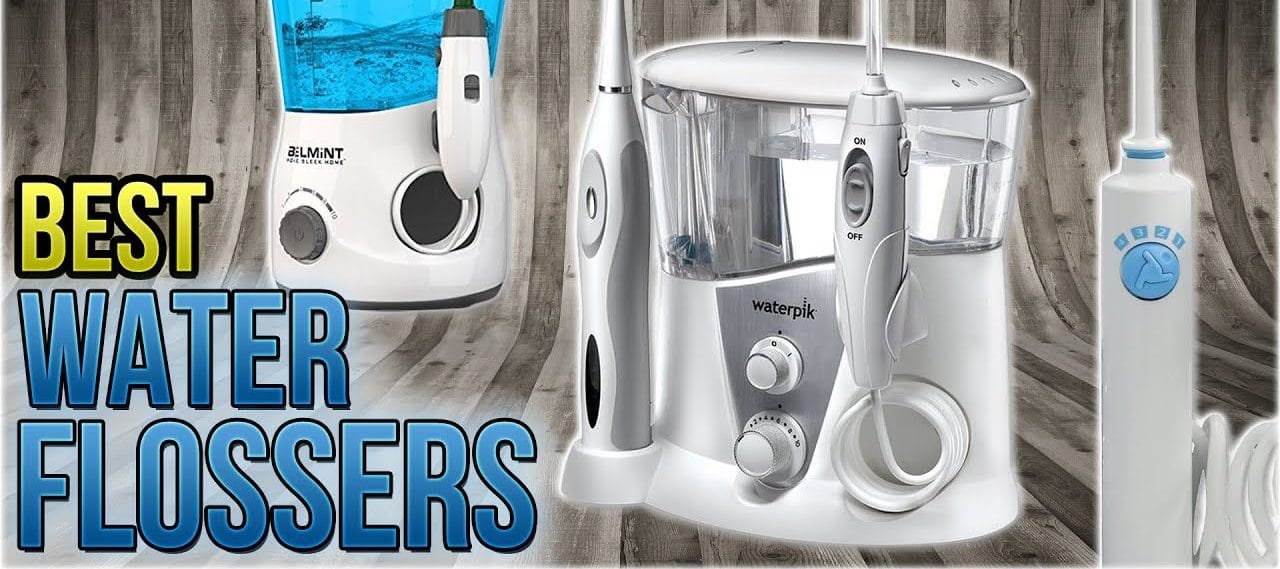
Best Water Flossers of 2023 – Reviews and Buyer’s Guide
It was updated in Feb 2023. Unsure what type of Water Flosser you should buy? We at Best Dentist Guide have made this guide to explain everything you need to know!
I have also included and reviewed the best items on the market to buy in 2020.
Flossing is a vital part of your daily dental routine; it helps to get in and clean the details of your teeth that a brush cannot. However, studies indicate that over 50% of Americans do not floss daily, which is where the water flosser comes in.
What is a Water Flosser?
Contents
- My Experience
- Features to Compare
- Review: Waterpik Aquarius Water Flosser, WP-660
- Review: Panasonic Portable Dental Water Flosser
- Review: Waterpik Water Flosser For Kids, WP-260
- Review: Cordless Oral Irrigator by ToiletTree Products
- Review: QuickBreeze EZ Dental Irrigator
- How to use a Water Flosser
- What Type of Water Flosser Should I Choose?
- Should I Brush or Floss First?
- Conclusion
A water flosser (also known as a water pick or an oral irrigator) is an oral cleaning device that shoots streams of water at your teeth.
It has many benefits of traditional flossing, removing plaque and food particles from your teeth and helping combat gum disease and bleeding.
Many people don’t use string floss because of sore or sensitive gums or braces or because many people hate manual flossing. Water flossers can be a great alternative.
Best Water Flossers
Here are some of the most popular water flossers. The most common brand across America is Waterpik.
My Experience
The first water flosser I used was a Waterpik Aquarius on Amazon. My history of traditional string flossing has been patchy. It felt a bit strange using this the first few times, but after checking up online, I read that I should start with a low setting and help my gums and mouth adjust to using the device.
The cleaning was a lot better when it got to higher settings. However, it took a bit of getting used to it before I could work up to this level.
When I got into using this, it made my teeth and mouth feel clean; it got rid of particles and stuff caught between my teeth. Most importantly, my gums stopped bleeding, which was happening quite a lot when brushing.
Before buying a water flosser, one of the first things I checked was its effectiveness compared to string flossing. The clinical research is up-and-coming.
Also, I do a much more thorough job with water flossing than a string, particularly on my back teeth. Check out some clinical research links from the American Dental Hygienists Association website and this paper over at the US National Library of Medicine site.
Here are a few tips:
- Use warm water in the reservoir: I initially used cold water, which felt similar to biting into ice cream, and it felt a lot better when I switched to warmer water.
- Point it at a 90% angle from your gum line and start at the back of your mouth.
- This product has a pause button to stop the flow of water. Make sure to press this when turning it on. Otherwise, it can end up in a mess!
- Only open your mouth slightly and lean over to let the water flow gently from your mouth. This can take a bit of getting used to!
- The Waterpik came with many attachable tips; my favorite was the Classic Jet Tip.
- I use the water flosser before brushing. But it’s a matter of preference, and there are different schools of thought about which way is better.
What are the Different Types of Water Flossers?
Water flossers fall into the following categories:
Countertop: These are sturdy units with large reservoirs. Perfect for those looking for a permanent place for their water flosser and families. It’s convenient as the large reservoir and placement allow quick access before or after brushing.
Cordless: These portable models are great for travel or those with less bathroom space. The main disadvantage is the smaller reservoir size, which means more frequent refills.
Kids: These are water flossers explicitly designed for kids, and the units and handles are smaller in size and feature more child-friendly electrics.
Faucet attachments: These are oral irrigators that connect directly to your faucet, eliminating the need for a reservoir. These are less popular than the reservoir models.
Features to Compare
- Reservoir size: This will dictate how long you will be able to floss before having to refill the reservoir. This depends on your pressure setting, but 5 ounces will usually provide around 30 seconds, and 22-ounce pools can provide up to 90 seconds of flossing time. Note: Faucet flossers do not require a reservoir as they get their water source directly from the faucet.
- The number of water pressure settings: Water flossers can have numerous different pressure settings. It is recommended to start low and work your way up; therefore, having multiple other locations allows you to work up slowly. High settings will enable more thorough cleaning.
- Tips: Some water flossers have various suggestions for different purposes, such as specific to people with braces, plaque targeting, and general cleaning. These are much more common in countertop models as they are generally more feature-rich.
- Handle size: The flosser handle size will vary compared to adult or kid’s models
- Pause button: A break or handle on/off switch allows you to stop the water flow. Getting an item with one of these is recommended, as not having one can leave you and your bathroom soaked if you are not careful.
- Size: If countertop models take up too much space, you can opt for cordless models or faucet flossers.
Review: Waterpik Aquarius Water Flosser, WP-660
This is a top seller in countertop water flossers, which packs many features with full-quality cleaning. Click here for more info and Amazon customer reviews.
- Ten pressure control settings
- Seven different tips for different purposes: Between everyday cleaning to recommendations suited for braces, tongue cleaning, plaque targeting, and more.
- On/Off button
- 90-second reservoir capacity
Pros:
- This packs many features as a great brand countertop model with top-quality flossing.
- The variety of pressure control settings sallows you to choose the optimum instead of simply ‘high’ or ‘low’ settings.
- Multiple tip options allow you to use various cleaning types suited to you.
- A prevalent model with very positive results.
- Good warranty – 3 years
- Attractive, modern design
Cons:
- As a countertop model, it is inherently not as easy to travel around with as cordless models.
- The on/off switch takes time; you must learn to hit it from the right angle.
- Only two tips can be stored in the unit’s lid at any one time, and it would be nicer if this could house all of them instead.
If you want to learn more, I have written a more detailed review of the Waterpik Aquarius.
Review: Panasonic Portable Dental Water Flosser
A prevalent cordless model is the Panasonic Portable Dental Water Flosser (Model: EW-DJ10-A). This great option provides a very effective clean on battery power, with equally effective performance to countertop models. Click here for more info and customer reviews.
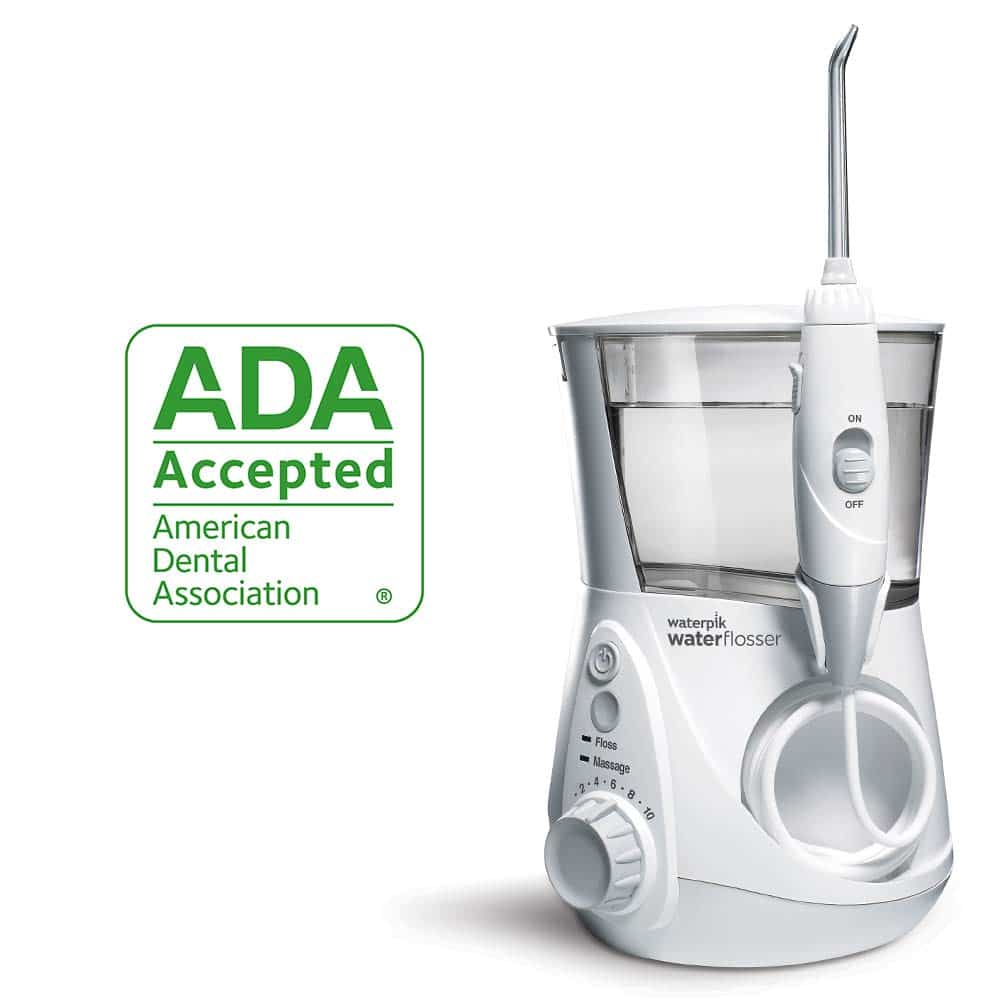 Features:
Features:
- Portable and cordless, battery-powered
- Dual speed – High and low speeds. High speed is the standard, and low speed is used for getting your gums used to the flosser, for people with gum problems, and for kids (There are also separate ‘water flossers that you can purchase).
- Collapsible Design – Very useful for traveling
Pros:
- Compact and cordless – great for traveling
- Easy to fill
- Easy to clean, with all parts being waterproof
- Long-lasting battery life (average of a month)
- Multidirectional
Cons:
- Uses AA batteries. It would be nicer if these used Lithium-ion batteries; however, this eliminates the need for a charging unit.
- As a cordless 5.5 oz reservoir, it is inherently smaller than countertop units.
- The unit can be a bit bulky for kids. Smaller water flossers are recommended for them.
Review: Waterpik Water Flosser For Kids, WP-260
This is the top water flosser exclusively designed for kids. It features a smaller handle, a more accessible-to-operate function, a more fun design, and a child-proof electrical design. Getting kids to floss can be a nightmare; the Waterpik water flosser makes this a whole lot easier and is an excellent opportunity for young kids with braces. The model is designed for kids six years and up.
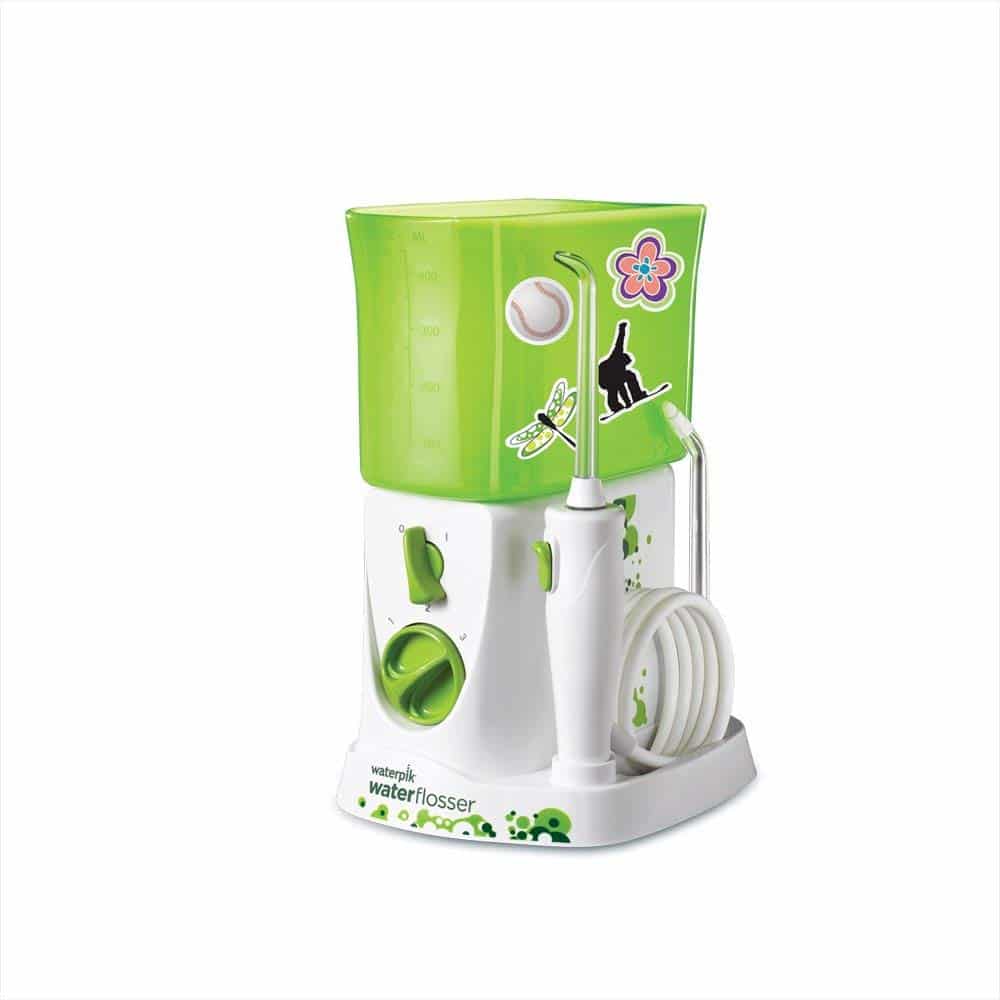 Also, one water flosser can be used for multiple children, as the tips are removable, and more can be bought separately. Some adults have also chosen to use this model for themselves as it takes up less space on the countertop. However, it is less powerful and holds fewer features specific to adults. Click here for more info and Amazon customer reviews.
Also, one water flosser can be used for multiple children, as the tips are removable, and more can be bought separately. Some adults have also chosen to use this model for themselves as it takes up less space on the countertop. However, it is less powerful and holds fewer features specific to adults. Click here for more info and Amazon customer reviews.
Features:
- Smaller handle
- Three pressure settings
- 60 seconds of water capacity
- Warranty for two years
- Two tips included
- Fun design!
Pros:
- Great way to get your children to floss, especially those with braces.
- Trusted brand
- Fun for kids to use!
- Very effectively cleaning
- Easy to use
- Safe electrical design
- Dual voltage
- Kids can share (using different tips)
- Good warranty
Cons:
- No pause button compared to the adult versions
- No reservoir lid
- The high-pressure setting can be too high for some kids; start with a low set.
Review: Cordless Oral Irrigator by ToiletTree Products
This is a very popular water oral irrigator by ToiletTree products. It is a cordless model which allows for great portability and traveling. Click here for more info and Amazon customer reviews.
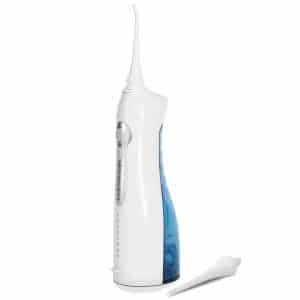 Features
Features
- Rechargeable – Uses lithium-ion batteries
- Universal voltage
- 3 Modes (Normal, Soft, Pulse)
Pros
- No need to buy batteries like some other cordless models; the charge lasts up to a few weeks with daily use.
- Easy to fill the reservoir
- Universal voltage makes this travel-friendly
- Cordless model
- Easy tip release
Cons
- The on/off button takes a bit of getting used to
- Some find the water reservoir a little small
Review: QuickBreeze EZ Dental Irrigator
This water flosser attaches directly to your faucet, eliminating the need for a water reservoir. This product has an aerator that attaches to your tap; you can snap the water flosser valve on and off as needed! Click here for more info and Amazon customer reviews.
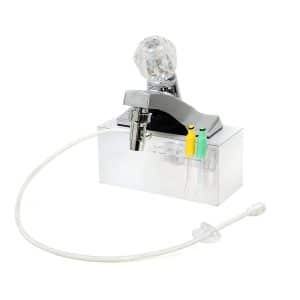 Features:
Features:
- It fits standard US plumbing (15/16\”- 27×55/64\”-27 inside/outside thread) and the plumbing of many other countries.
- Lifetime warranty
- Simple installation and operation
- Easy snap-on and snap-off release from faucet aerator
Pros:
- Easy to install and fit
- Easy to use
- Universal fitting for US plumbing
- Never need to refill water
- Water pressure highly adjustable by your water faucet
Cons:
- It does not have a pulsating mode like Waterpiks or other stand-alone units.
- Lacking in features of counter-top models
- Not as suitable for travel as cordless water flossers, as it requires installing the aerator to the sink.
How to use a Water Flosser
Not sure how to use a Water Flosser? See the below steps. This is using a Waterpik counter-top model as an example:
- Make sure that your Water Flosser is clean. Rinse it through and wipe it off with a cloth.
- Fill the reservoir with clean water. If your teeth are susceptible, you may fill them with warm water, but make sure that the water is clean.
- Select your tip if multiple ones are available (If you are unsure, you can start with the Classic Jet Tip for Waterpik models).
- Start on the lowest pressure, and press the pause button
- Turn on the power button
- Start water flossing and turn up the most comfortable pressure. If it is painful, then stop and immediately decrease the water pressure.
- Close your lips while flossing and lean over the sink to let water flow out of your mouth. This may take a little training as it differs from the action you will do while brushing.
- Start with the back teeth at a 90% angle to the gum line and work forwards.
- Make sure to keep up the habit daily!
See below instructional video by Water Flosser manufacturer Waterpik:
What Type of Water Flosser Should I Choose?
- If you want a permanent space for your flosser, choose a countertop model because this has the most features and significant reservoirs.
- Get a Cordless water flosser for those with little space or who want a portable model.
- If the model is for kids, buy a Kid’s water flosser.
- If you don’t want to refill your reservoir, choose a faucet attachment model (however, these are less popular).
Should I Brush or Floss First?
This question came up when I started living with my Fiancé. Before bed, he began to question why I was flossing before brushing. I had never considered it before, as it had simply been what my parents had taught me. It turns out that there are two different schools of thought on this subject.
- Flossing Before Brushing: This first school of thought is recommended by the American Dental Association. It is based on the idea that you should floss to dislodge the plaque that build-up between your teeth first. Brushing will then remove the plaque, clear away any remainder, and give fluoride in your toothpaste a chance to get to those hard-to-reach areas between your teeth.
- Brushing Before Flossing: The argument between brushing first is that this will dislodge and tackle some of the plaque between your teeth (especially if using interdental toothbrushes). Then when flossing, it will completely get rid of the remaining plaque.
I’m happy to be still flossing before brushing based on this research. However, it is still entirely up to you. One of these methods may be better, and the benefits and improvement to your oral health may be similar. The essential thing is that you make sure to floss every day.
Brushing alone does not do an excellent job of cleaning your teeth; it just so happens that this is where most gum problems and diseases occur. So if you are still unsure if you should be flossing before or after, then pick one! Doing so consistently will do wonders for your dental health, reduce bleeding, and save you from some severe dental bills further down the line.
Conclusion
So that’s a list of my top recommended Water Flossers and a Buyer’s guide to help you figure out what to look out for and pick the perfect one.
Remember that your teeth and gum health are essential. If you can, floss with a water flosser and string floss together to get an excellent clean. But make sure to start with at least something today! The investment in a water flosser is minimal compared to the pain, stress, and financial worries associated with poor gum health and problems.
Most of all, pick the one that’s right for you, keep up the habit, and go at least 30 days with flossing daily to make sure you stick to your routine. You and your dentist will be happy you did!
Recommended Water Flosser: Waterpik Aquarius
I’ve chosen this model as it is highly effective and has features, tips, and settings that should suit everyone. Waterpik is at the top of this industry, and you know you are getting quality and tested products by choosing them.
If you’re unsure which one to get, you won’t be disappointed with the Waterpik Aquarius.







